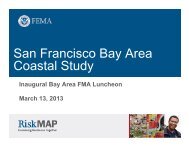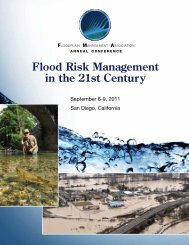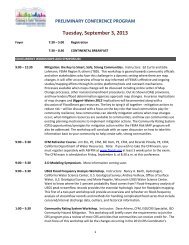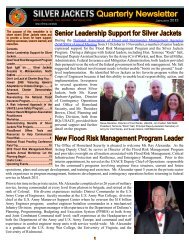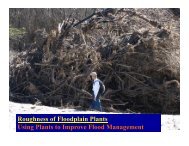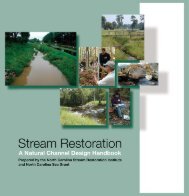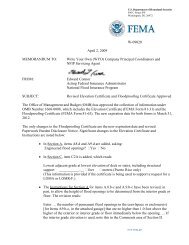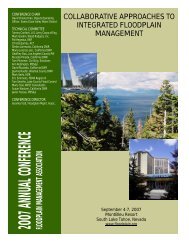Using Multi-Objective Management to Reduce Flood Losses in Your
Using Multi-Objective Management to Reduce Flood Losses in Your
Using Multi-Objective Management to Reduce Flood Losses in Your
You also want an ePaper? Increase the reach of your titles
YUMPU automatically turns print PDFs into web optimized ePapers that Google loves.
water is runn<strong>in</strong>g off the land <strong>in</strong><strong>to</strong> Small Creek and human development helps it get<br />
there even faster.<br />
The amount of water that used <strong>to</strong> come downstream once every 20 or 30<br />
years now comes down about every 10 years. Because of the build<strong>in</strong>gs, roads, and<br />
small bridge open<strong>in</strong>gs, there is less room <strong>in</strong> the floodpla<strong>in</strong> <strong>to</strong> carry the extra<br />
water. <strong>Flood</strong> waters rise higher, cover a larger area, and flood farmlands, roads,<br />
utilities, build<strong>in</strong>gs, and other development that had never been flooded before.<br />
In addition, the channel banks are exposed <strong>to</strong> faster-mov<strong>in</strong>g waters and<br />
have become more susceptible <strong>to</strong> erosion. Higher flood waters runn<strong>in</strong>g across bare<br />
construction sites and tilled farm lands cause more erosion and carry sediment <strong>in</strong><strong>to</strong><br />
the streams and lakes.<br />
Pollutants from lawn fertilizers, pesticides, farm chemicals, street surfaces,<br />
and <strong>in</strong>dustrial areas are also delivered <strong>to</strong> the rivers and lakes. Many beneficial<br />
plants and animals are harmed or exterm<strong>in</strong>ated by these pollutants and sediments.<br />
The orig<strong>in</strong>al species are be<strong>in</strong>g replaced by different ones that may not be desirable<br />
or beneficial <strong>to</strong> the rivers, lakes, or environment.<br />
It can be seen that there is a close relationship between natural flood<strong>in</strong>g,<br />
development <strong>in</strong> the floodpla<strong>in</strong>, and what happens <strong>in</strong> the rest of the watershed. As<br />
a general rule, the smaller the watershed, the more quickly it reacts <strong>to</strong> changes.<br />
As one experienced floodpla<strong>in</strong> manager has put it, “You don’t solve flood<br />
problems by work<strong>in</strong>g at the bot<strong>to</strong>m of the hill.” You must look at the whole<br />
picture−where the water comes from and where it goes.<br />
Coastal <strong>Flood</strong><strong>in</strong>g<br />
Areas along the seashore or lakeshores are prone <strong>to</strong> coastal flood<strong>in</strong>g and erosion.<br />
Coastal flood<strong>in</strong>g happens dur<strong>in</strong>g s<strong>to</strong>rms that drive water on<strong>to</strong> adjacent land. These<br />
can be hurricanes, “nor’easters,” or tropical s<strong>to</strong>rms, but even a severe w<strong>in</strong>ter<br />
s<strong>to</strong>rm or thunders<strong>to</strong>rm can cause flood<strong>in</strong>g.<br />
<strong>Flood</strong><strong>in</strong>g<br />
Coastal flood<strong>in</strong>g or s<strong>to</strong>rm surge is caused by high water from w<strong>in</strong>d and the air<br />
pressure differences that accompany a s<strong>to</strong>rm. A s<strong>to</strong>rm surge is not a tidal wave or<br />
sudden rush of water; it is more of a gradual <strong>in</strong>crease <strong>in</strong> water level. While this<br />
may sound harmless, a surge can be as high as 20 feet above normal water levels,<br />
flood<strong>in</strong>g normally dry areas far <strong>in</strong>land. Most of the damage and deaths caused by<br />
a hurricane are the result of flood<strong>in</strong>g, not high w<strong>in</strong>ds.<br />
Like communities with river<strong>in</strong>e flood<strong>in</strong>g, most coastal communities<br />
have a <strong>Flood</strong> Insurance Rate Map that shows their base floodpla<strong>in</strong>s. The maps<br />
also show the parts of the floodpla<strong>in</strong> subject <strong>to</strong> high damage potential from waves,<br />
known as velocity zones.<br />
Another form of coastal flood<strong>in</strong>g may or may not be shown on the<br />
map. A tsunami is a wave that is caused by an earthquake under the ocean.<br />
Tsunamis are not tidal waves nor are they related <strong>to</strong> s<strong>to</strong>rms, because they can<br />
happen on a clear day as a result of seismic activity hundreds of miles away. They<br />
can produce flood levels far above the mapped base floodpla<strong>in</strong>. In this country,<br />
they are most common on the Pacific coast, especially <strong>in</strong> Alaska, Hawaii, and the<br />
Northwest.<br />
8



